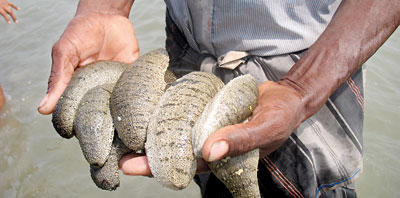News
Sea cucumber hatchery to give momentum to industry
View(s):By Malaka Rodrigo
The construction of a new sea cucumber hatchery was initiated in Mannar yesterday at a cost of Rs 180 million rupees, says Nimal Chandraratne, the director general of National Aquaculture Development Authority of Sri Lanka.
Once completed this year, the hatchery will produce a million juvenile sea cucumbers annually, Chandraratne assured.
Sea cucumbers are bottom-dwelling primitive marine invertebrates closely related to starfish and sea urchin. They have elongated soft bodies resembling the shape of a cucumber or a sausage, giving rise to its common English name. In Sinhala they are called ‘muhudu kudella’ (sea leach). East Asian countries regard sea cucumbers as a delicacy where it is commonly known as bêche-de-mer (literally “sea-spade”) in French, creating a lucrative market.

Sea cucumbers seen at Mannar . Pic courtesy Kumudini Ekaratne, IUCN
It is stated that the sea cucumber industry in Sri Lanka is quite old, having been introduced by the Chinese. Some old records mention that processed sea cucumbers appear to be one of the commodities taken to China during the last 1,000 years when trade existed via the silk route. But the demand has arisen sharply with a high price tag, so the industry surged in 1980s in coastal areas. They are dried and the entire processed harvest has been exported to countries like Singapore, China, Hong Kong, Taiwan bringing much needed foreign exchange.
The sea cucumber is a slow-moving animal that allows easy collection, so it was soon over-harvested in many areas. On average, a hectare of sea bottom should have a population of about 30 individuals, but a survey by the National Aquatic Resources Research and Development Agency, a decade ago, revealed the number has dropped to one or two individuals in some areas, according to senior scientist Ajith Kumara.
In Sri Lanka, 27 different species of sea cucumbers are found, but the high value species are mainly confined to north, east and north-western coastal areas. The war had deterred over-exploitation with restrictions on maritime operations, but the post-war scenario seems to be detrimental to sea cucumbers.
A study funded by the Mangroves for the Future, carried out for six months between October 2013 and June 2014 by the University of Jaffna, found that the population is depleted in the Jaffna Lagoon. According to the study of 29 sites in the Jaffna Lagoon only10 locations had any sea cucumbers. The total in the 10 sites was only 360 individuals. But another survey between 1980 and 1981 recorded 20-160 individuals of high-value sea cucumber species per square metre.
The sea cucumber species called sandfish (holothuria scabra) that has higher value in the market is now categorized as ‘endangered’ by the IUCN Red List of threatened fauna. So the industry is doomed to collapse without intervention.
Against this backdrop, the sea cucumber farms are being introduced in Sri Lanka. A number of farms are already operating and the Mannar hatchery will help produce juveniles for farms.
Chandraratne of NAQDA said that holothuria scabra, that has a high demand, will be bred in the hatchery. The creatures will be artificially bred. At present there is a privately-owned hatchery and another operated by NARA.
Chandraratne said there are plans to establish a sea cucumber farm in Nainathivu and more hatcheries later.
NARA’s inland aquaculture and aquatic resources division researched to develop technology for breeding sea cucumbers since 2011 at their Kalpitiya field station independently.
Scientist Kumara said it was difficult to distinguish male and female sea cucumbers, so about 50 individuals are put into a tank and given a thermal shock by increasing the temperature of the water in the container and cooling it down quickly. This results in the male sea cucumber releasing sperm. Then the female starts to release eggs.
One female releases several million eggs, but very few hatch, Kumara explained.
Kumara said they are working closely with the community to protect the sea cucumber fishery by releasing some of the hatched juveniles into the natural environment.
Fisheries expert Dr Steve Creech, emphasized the importance of having a management strategy for Sri Lanka’s sea cucumber fishery to save the free living population. He recognizes the issue of open access for Sri Lankan sea cucumber fisheries that will further deplete the natural living species. So he suggests there should be harvest control strategies based on annual assessment of the status of the stocks. Dr Creech thinks that sea cucumber farming is a good development with low impact on the environment and ecosystem and fishing.
| FISHERMEN, 302 SEA CUCUMBERS SEIZED Fourteen fishermen were arrested by the navy on February 20 for illegally gathering sea cucumber. They were arrested in the Keeramunal area and 302 sea cucumbers, a dinghy, and diving gear were seized. They were handed over to the fisheries inspector at Kilinochchi the navy said. The navy has often intercepted smugglers bringing sea cucumbers from India, mostly in dried form. Due to over-harvesting, India banned gathering of sea cucumbers from the wild, so racketeers are not allowed to export the sea cucumbers through India. It is believed they are selling their stocks to Sri Lankans who can re-export taking advantage of loopholes in regulations. | |

